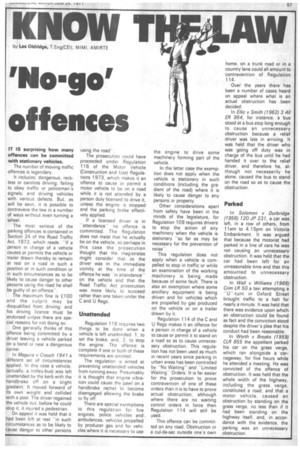KNOW T
Page 59

If you've noticed an error in this article please click here to report it so we can fix it.
by Les Oldridge, T.Eng(CEI), MIMI, AMIRTE
'No-go' offences
IT IS surprising how many offences can be committed with stationary vehicles.
The number of moving traffic offences is legendary.
It includes: dangerous, reckless or careless driving; failing to obey traffic or policeman's signals; and driving vehicles with various defects. But, as will be seen, it is possible to contravene the law in a number of ways without even turning a wheel.
The most serious of the parking offences is contained in Section 24 of the Road Traffic Act, 1972, which reads: "If a person in charge of a vehicle causes or permits the vehicle or trailer drawn thereby to remain at rest on a road in such a position or in such condition or in such circumstances as to be likely to cause danger to other persons using the road he shall be guilty of an offence".
The maximum fine is E100 and the culprit may be disqualified from driving; and his driving licence must be endorsed unless there are special reasons for not doing so.
One generally thinks of this offence being committed by a driver leaving a vehicle parked on a bend or near a dangerous corner.
In Maguire v Crouch 194 1 a different set of circumstances applied. In this case a vehicle, (actually, a trolley-bus) was left unattended by the kerb with the handbrake off on a slight gradient. It moved forward of its own weight and collided with a post. The driver regained the vehicle but, before he could stop it, it injured a pedestrian.
On appeal it was held that it had been left at rest "in such circumstances as to be likely to cause danger to other persons -using the road".
The prosecution could have proceeded under Regulation 116 of the Motor Vehicle (Construction and Use) Regulations 1973, which makes it an offence to cause or permit a motor vehicle to be on a road while it is not attended by a person duly licensed to drive it, unless the engine is stopped and the parking brake effectively applied.
If a licensed driver is in "attendance" no offence is committed. The Regulation does not insist that he actually be on the vehicle, so perhaps in this case the prosecution thought that the magistrates might consider that as the driver was in the immediate vicinity at the time of the offence he was "in attendance" on the vehicle and that the Road Traffic Act prosecution was more likely to succeed rather than one taken under the C and U Regs.
Unattended
Regulation 11 6 requires two things to be done when a vehicle is left unattended: 1, to set the brake; and, 2, to stop the engine. The offence is complete if one or both of these requirements'are omitted.
The regulation is aimed at preventing unattended vehicles from running away. Presumably it is thought that engine vibration could cause the pawl on a handbrake rachet to become disengaged allowing the brake to fly off.
There are special exemptions to this regulation for fire engines, police vehicles and ambulances, vehicles propelled by producer gas and for vehicles where it is necessary to use the engine to drive some machinery forming part of the vehicle.
In the latter case the exemption does not apply when the vehicle is stationary in such conditions (including the gradient of the road) where it is likely to cause danger to any persons: or property.
Other considerations apart from safety have been in the minds of the legislature, for Regulation 109 requires drivers to stop the action of any machinery when the vehicle is stationary "so far as may be necessary for the prevention of noise".
This regulation does not apply when a vehicle is com pelled to stop in traffic or while an examination of the working machinery is being made because of some fault. There is also an exemption where some ancillary equipment is being driven and for vehicles which are propelled by gas produced on the vehicle or on a trailer drawn by it.
Regulation 114 of the C and U Regs makes it an offence for a person in charge of a vehicle to cause or permit it to stand on a road so as to cause unneces sary obstruction. This regula tion has not been used as much in recent years since parking in urban areas has been controlled by "No Waiting" and "Limited Waiting'' Orders. It is far easier for the prosecution to prove contravention of one of these orders than it is to have to prove actual obstruction, although where there are no waiting control orders in force then Regulation 114 will still be used.
This offence can be committed on any road. Obstruction in a cul-de-sac outside one's own




































































































